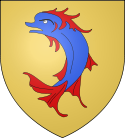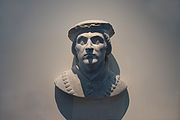
Dauphin de Viennois
Encyclopedia

Under Guigues IV, Count of Albon, who was nicknamed le Dauphin or the Dolphin from the dolphin on his coat of arms
Coat of arms
A coat of arms is a unique heraldic design on a shield or escutcheon or on a surcoat or tabard used to cover and protect armour and to identify the wearer. Thus the term is often stated as "coat-armour", because it was anciently displayed on the front of a coat of cloth...
, they took a new hereditary title, Dauphin of Viennois (Dauphin de Viennois), named for the region around Vienne
Vienne, Isère
Vienne is a commune in south-eastern France, located south of Lyon, on the Rhône River. It is the second largest city after Grenoble in the Isère department, of which it is a subprefecture. The city's population was of 29,400 as of the 2001 census....
, where they ruled. The collective lands ruled by the Dauphins of Viennois became known as the Dauphiny
Dauphiné
The Dauphiné or Dauphiné Viennois is a former province in southeastern France, whose area roughly corresponded to that of the present departments of :Isère, :Drôme, and :Hautes-Alpes....
(le Dauphiné).
The titles and lands, many of which were within the legal boundaries of the Holy Roman Empire
Holy Roman Empire
The Holy Roman Empire was a realm that existed from 962 to 1806 in Central Europe.It was ruled by the Holy Roman Emperor. Its character changed during the Middle Ages and the Early Modern period, when the power of the emperor gradually weakened in favour of the princes...
rather than of the kingdom of France
France
The French Republic , The French Republic , The French Republic , (commonly known as France , is a unitary semi-presidential republic in Western Europe with several overseas territories and islands located on other continents and in the Indian, Pacific, and Atlantic oceans. Metropolitan France...
, were all sold to King Philip VI of France
Philip VI of France
Philip VI , known as the Fortunate and of Valois, was the King of France from 1328 to his death. He was also Count of Anjou, Maine, and Valois from 1325 to 1328...
in 1349, on condition that the heir to the French crown
Crown Prince
A crown prince or crown princess is the heir or heiress apparent to the throne in a royal or imperial monarchy. The wife of a crown prince is also titled crown princess....
always be named Dauphin, and be personal holder of the lands and titles. By condition of the Emperor, the Dauphiny could never be united to France. When the King of France had no son, he would personally rule the Dauphiny separately, as Dauphin.
House of Albon
- Guigues I of Albon the Old (c. 1000–1070), Count in Oisans, Grésivaudan and Briançonnais, Lord of Château d'Albon, ruled until 1070
- Guigues II of Albon the Fat (c. 1020–1079), Count in Grésivaudan and Briançonnais, Lord of Château d'Albon, ruled 1070–1079
House of Albon
- Guigues III of Albon the Count (c. 1050–1133), first Count of Albon (the southern part of the ancient County of Vienne, divided between himself and the Count of Savoy), ruled 1079–1133
- Guigues IV of Albon, le Dauphin (c. 1095–1142), Count of Albon, ruled 1133–1142
Counts of Albon and Dauphins of Viennois
- Robert V, Count of Auvergne married Marquise d'Albon, a daughter of Guigues IV. Their descendants adopted the title of Dauphin of Auvergne, and it was used by some as the family name.
House of Albon
- Guigues V of Albon (c. 1120–1162), Count of Albon and Grenoble, Dauphin of Viennois, ruled 1142–1162
- Béatrice of AlbonBéatrice of AlbonBéatrice, Countess of Albon and Dauphine of Viennois became countess and dauphine in 1162 upon the death of her father Guigues V.She married Hugh III, Duke of Burgundy in 1183 and had three children:...
(1161–1228), Dauphine of Viennois, Countess of Albon, Grenoble, Oisans et Briançon, ruled 1162–1228, married Hugh III of Burgundy
House of BurgundyHouse of BurgundyThe House of Burgundy was a cadet branch of the Capetian dynasty, descending from Robert I, Duke of Burgundy, a younger son of Robert II of France....
- Guigues VI of Viennois (1184–1237), Dauphin de Viennois, count of Albon, Grenoble, Oisans and Briançon, ruled 1228–1237
- Guigues VII of Viennois (c. 1225–1269), Dauphin of Viennois, Count of Albon, Grenoble, Oisans, Briançon, Embrun and Gap, son of, ruled 1237–1269
- John I of Viennois (1263–1282), Dauphin of Viennois, Count of Albon, Grenoble, Oisans, Briançon and Embrun, ruled 1269–1282
- Anne of Viennois (1255–1298), Dauphine of Viennois, Countess of Albon, married Humbert, Baron of La Tour du PinHumbert I of ViennoisHumbert I of Viennois was baron of la Tour-du-Pin and then also became, by his marriage, dauphin of Viennois. He was the son of Albert IV, baron of la Tour-du-Pin, and of Béatrice de Coligny .In 1273 he married Anne of Burgundy -...
House of La Tour du Pin

- Humbert I of ViennoisHumbert I of ViennoisHumbert I of Viennois was baron of la Tour-du-Pin and then also became, by his marriage, dauphin of Viennois. He was the son of Albert IV, baron of la Tour-du-Pin, and of Béatrice de Coligny .In 1273 he married Anne of Burgundy -...
(c. 1240–1307), Baron of La Tour du Pin, Dauphin of Viennois and Count of Albon, ruled 1282–1307 - John II of ViennoisJohn II of ViennoisJean II de la Tour du Pin succeeded his father Humbert I as dauphin of Viennois from 1306 to 1318. His mother was Anne of Burgundy, dauphine du Viennois....
(1280–1318), Baron of La Tour du Pin, Dauphin of Viennois, ruled 1307–1318 - Guigues VIII of Viennois (1309–1333), Dauphin of Viennois, ruled 1318–1333
- Humbert II of ViennoisHumbert II of ViennoisHumbert II de la Tour-du-Pin was the Dauphin of the Viennois from 1333 to 16 July 1349. He was a son of the Dauphin John II and Beatrice of Hungary...
(1312–1355), Dauphin of Viennois, ruled 1333–1349
Humbert II sold his lands and titles to Philip VI of France
Philip VI of France
Philip VI , known as the Fortunate and of Valois, was the King of France from 1328 to his death. He was also Count of Anjou, Maine, and Valois from 1325 to 1328...
.
House of Valois
- Charles I of ViennoisCharles V of FranceCharles V , called the Wise, was King of France from 1364 to his death in 1380 and a member of the House of Valois...
(1338–1380), also king of France as Charles V, Dauphin of Viennois, Count of Diois and Valentinois, Duke of Normandy, ruled the dauphinate as the first Dauphin of France (1350–1364) and ruled the dauphinate as king of France (1364–1366) - John III of Viennois, Dauphin of Viennois, Count of Diois and Valentinois, ruled the dauphinate as second Dauphin of France (1366)
- Charles I of ViennoisCharles V of FranceCharles V , called the Wise, was King of France from 1364 to his death in 1380 and a member of the House of Valois...
, ruled the dauphinate as king of France (1366–1368) - Charles II of ViennoisCharles VI of FranceCharles VI , called the Beloved and the Mad , was the King of France from 1380 to 1422, as a member of the House of Valois. His bouts with madness, which seem to have begun in 1392, led to quarrels among the French royal family, which were exploited by the neighbouring powers of England and Burgundy...
(1368–1422),also king of France as Charles VI, Dauphin of Viennois, Count of Diois and Valentinois, ruled the dauphinate as third Dauphin of France (1368–1380), ruled the dauphinate as king of France (1380–1386) - Charles III of Viennois (1386), Dauphin of Viennois, Count of Diois and Valentinois, ruled the dauphinate as fourth Dauphin of France (1386)
- Charles II of ViennoisCharles VI of FranceCharles VI , called the Beloved and the Mad , was the King of France from 1380 to 1422, as a member of the House of Valois. His bouts with madness, which seem to have begun in 1392, led to quarrels among the French royal family, which were exploited by the neighbouring powers of England and Burgundy...
, ruled the dauphinate as king of France (1386–1392) - Charles IV of Viennois (1392-1401), Dauphin of Viennois, Count of Diois and Valentinois, Duke of Guyenne, ruled the dauphinate as fifth Dauphin of France (1392–1401)
- Louis I of ViennoisLouis, Dauphin of France (1397-1415)Louis, Dauphin of France and Duke of Guyenne was a younger son of Charles VI of France and Isabella of Bavaria-Ingolstadt...
(1397–1415), Dauphin of Viennois, Count of Diois and Valentinois, Duke of Guyenne, ruled the dauphinate as sixth Dauphin of France (1401–1415) - John IV of Viennois (1398–1417), Dauphin of Viennois, Count of Diois and Valentinois, Duke of Touraine, ruled the dauphinate as seventh Dauphin of France (1415–1417)
- Charles V of ViennoisCharles VII of FranceCharles VII , called the Victorious or the Well-Served , was King of France from 1422 to his death, though he was initially opposed by Henry VI of England, whose Regent, the Duke of Bedford, ruled much of France including the capital, Paris...
(1403–1461), also king of France as Charles VII, Dauphin of Viennois, Count of Diois, Valentinois and Ponthieu, ruled the dauphinate as eighth Dauphin of France (1417–1422), ruled the dauphinate as king of France/King of Bourges (1422–1423/1429) - Louis II of ViennoisLouis XI of FranceLouis XI , called the Prudent , was the King of France from 1461 to 1483. He was the son of Charles VII of France and Mary of Anjou, a member of the House of Valois....
(1423–1483), also king of France as Louis XI, Dauphin of Viennois, Count of Diois and Valentinois, ruled the dauphinate as ninth Dauphin of France (1423/1429–1461), ruled the dauphinate as king of France (1461–1466)
See also
- Dauphins of France
- Dauphins of Viennois
- Dauphins of Auvergne

